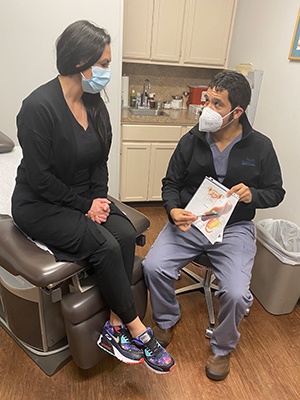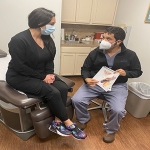Have you ever experienced upper abdominal pain or chest pain - maybe after you finished eating something greasy or when you bend over? Abdominal pain may be a result of either heartburn or gallbladder disease, but it can be difficult to tell them apart. Learning the differences between the two conditions will help you start a conversation with your doctor to ensure you get the right treatment and pain relief.

Heartburn
Heartburn, also known as gastroesophageal reflux disease or GERD, is a condition experienced by many people. Heartburn is usually felt right after you eat a large meal, and it can feel worse when you bend over or lay down. GERD can cause many additional symptoms, including:
- Anemia
- Difficulty swallowing
- Chronic cough
- Bronchitis
- Recurring pneumonia
Mild GERD can be controlled with lifestyle changes, such as:
- Avoiding things that cause reflux (tobacco, fatty foods, acidic foods, alcohol, caffeine, chocolate, peppermint, and spearmint)
- Eating smaller, more frequent meals, and not eating within 4 hours of bedtime
- Avoiding bending, stooping, sit-ups, and tight clothing
- Losing weight
- Elevating the head of the bed 6-8" with blocks
If maximal medical therapy is not working to control symptoms of GERD, surgery may be needed. Patients may also consider GERD surgery if they do not wish to take medication the rest of their life or if their symptoms are caused by a hiatal hernia. Surgery for GERD is known as laparoscopic fundoplication and can be performed using the da Vinci robot system. There may also be other surgical options based on patient specific criteria.
Gallbladder Disease
When a gallbladder is inflamed or contains stones it may not properly function, resulting in gallbladder disease. Abdominal pain that is caused by gallbladder disease is most commonly experienced in the right upper abdomen or just below your breastbone, but the pain may move to your back, shoulders, or chest. This pain often occurs after eating fried, greasy or fatty foods food, but it can occur at any time with any food.
In addition to abdominal pain, if you have gallbladder disease you might also be experiencing a variety of other symptoms, including:
- Nausea
- Vomiting
- Diarrhea
- Indigestion
- Bloating
- Fever
- Jaundice
While some patients with mild or intermittent symptoms can be managed with dietary changes, surgical removal of the gallbladder is the treatment of choice when patients become symptomatic. Gallbladder surgery, or laparoscopic cholecystecomy, is a common minimally invasive procedure that uses a camera and narrow instruments to view and remove the gallbladder. Most patients go home the same day and are able to recover quickly and with minimal pain.
Whether your abdominal pain is caused by gallbladder disease or heartburn, Austin Surgeons is here to help! For more information about these two conditions, visit austinsurgeons.net or call (512) 467-7151.
For the latest Austin Surgeons news, follow us on Facebook and Instagram.

